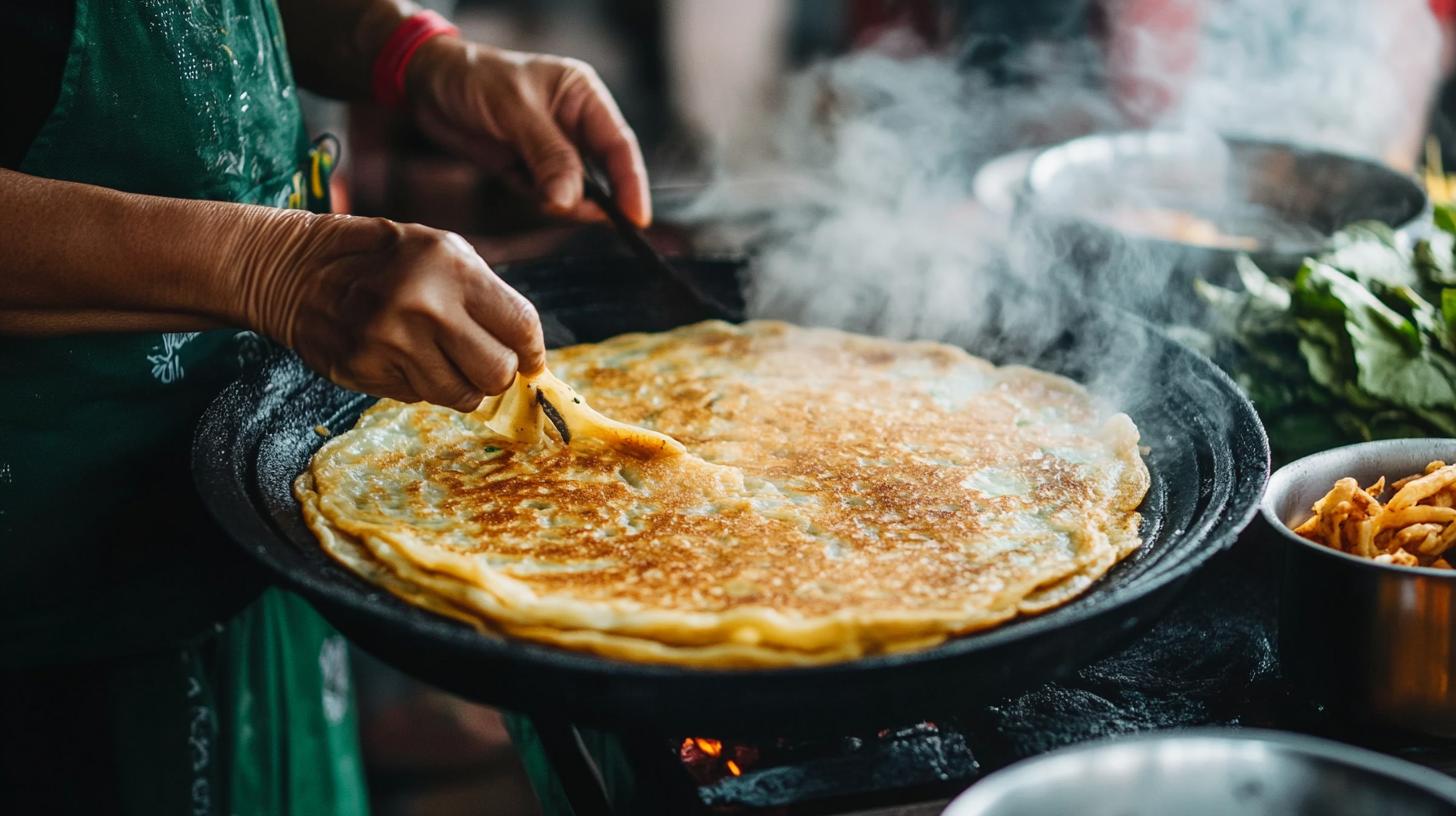Vietnamese Pancakes, or Bánh Xèo, are a tantalizing blend of textures and flavors, swiftly transporting you to the bustling streets of Vietnam with each delicious bite. These crispy, golden crepes are a testament to Vietnam’s rich culinary heritage, offering a unique combination of fresh ingredients and dynamic taste profiles. Legend has it that Bánh Xèo was crafted to mimic the gentle “sizzling” sound the batter makes when it hits a hot pan, an auditory nod to its irresistible appeal.
Bánh Xèo is a versatile dish; whether enjoyed as a light lunch, a festive appetizer at gatherings, or a hearty dinner, it’s sure to dazzle your taste buds and those of your guests. The delightfully crispy crepe encases a savory filling of shrimp, pork, and bean sprouts, all of which are perfectly complemented by the fresh crunch of lettuce and herbs, accompanied by a tangy dipping sauce. Originating from southern Vietnam, this dish represents a harmonious blend of French crepe-making techniques with local Vietnamese ingredients, creating a multi-sensory dining experience.
Ingredients
# For the Pancake Batter:
– 1 cup rice flour
– 1/4 cup cornstarch
– 1/2 teaspoon ground turmeric
– 1 cup coconut milk
– 1 cup water
– A pinch of salt
– 2 spring onions, thinly sliced
# For the Filling:
– 200g pork belly, thinly sliced
– 200g shrimp, peeled and deveined
– 2 cups bean sprouts
– Cooking oil
# For the Dipping Sauce (Nuoc Cham):
– 1/4 cup fish sauce
– 1/4 cup lime juice
– 2 tablespoons sugar
– 1/4 cup water
– 1 garlic clove, minced
– 1 small chili, sliced (optional)
– 1 tablespoon shredded carrot (optional)
# For Serving:
– Fresh lettuce leaves
– Fresh herbs (such as mint, basil, and cilantro)
Instructions
Step 1: Prepare the Batter
1. In a large bowl, whisk together rice flour, cornstarch, turmeric, coconut milk, water, and salt until smooth.
2. Stir in the sliced spring onions. Let the batter rest for at least 30 minutes to allow the flours to hydrate.
Step 2: Cook the Filling
1. Heat a drizzle of oil in a large frying pan over medium heat.
2. Add sliced pork belly and cook until lightly browned.
3. Add the shrimp and cook until they turn pink. Remove both from the pan and set aside.
Step 3: Make the Pancakes
1. Wipe the pan clean, then heat a tablespoon of oil over medium heat.
2. Pour in a ladleful of batter, swirling to cover the base of the pan thinly.
3. Scatter some cooked pork, shrimp, and bean sprouts over half of the pancake.
4. Cover with a lid and cook for about 3-4 minutes, or until the edges lift easily off the pan and the pancake is crispy.
5. Fold the pancake in half over the filling, then transfer to a plate.
6. Repeat with remaining batter and filling.
Step 4: Prepare the Dipping Sauce
1. In a small bowl, mix fish sauce, lime juice, sugar, and water until sugar is dissolved.
2. Stir in garlic, chili, and carrot if using.
Step 5: Serve and Enjoy!
1. Serve the Bánh Xèo hot with a platter of fresh lettuce leaves and herbs.
2. To eat, break off a piece of the pancake, wrap it in a lettuce leaf with herbs, and dip it into the sauce.
Tips and Pairing Suggestions
– Cooking Tip: Use a non-stick pan to prevent the pancakes from sticking and ensure they crisp up nicely.
– Serving Suggestion: For an added depth of flavor, try pairing your Bánh Xèo with a refreshing mango salad or a side of pickled vegetables.
– Pairing Idea: A light, crisp white wine such as Sauvignon Blanc or a fragrant jasmine tea makes a perfect accompaniment to this dish, enhancing its delicate flavors.
Experiment with your favorite fresh herbs or substitute pork and shrimp with chicken or tofu for a twist that suits your taste preferences. Vietnamese Pancakes are a delightful canvas—you’ll love personalizing this easy yet exotic dish!
The Hidden Story of Bánh Xèo: More Than Just a Pancake
Bánh Xèo, often celebrated for its sizzling appeal and vibrant flavors, holds a deeper historical and cultural significance that goes beyond the mere blending of ingredients. Did you know that this iconic Vietnamese dish is believed to have Buddhist roots? During fasting periods, Buddhists substitute the traditional pork and shrimp filling with mushrooms and tofu, presenting a delicious vegetarian variation that upholds the same craved-for crunch and zest.
Another captivating fact is that regional versions of Bánh Xèo vary notably within Vietnam. While the southern variety tends to be larger and more coconut milk-heavy, the central regions of Vietnam pride themselves on a smaller, crispier, and sometimes more turmeric-infused version. These nuances reflect the diverse climate and cultural influences across the country, providing a tantalizing range of flavors and textures for curious food enthusiasts to explore.
The French influence on Bánh Xèo, linked to the country’s colonial history, isn’t restricted to culinary techniques alone. They introduced the notion of using rice flour mixed with water, akin to crepe-making, revolutionizing the dish to what it is today. Yet, this blend sparked controversy among traditionalists who argue whether the dish’s authenticity is maintained in modern adaptations or if it dilutes Vietnamese culinary heritage.
Why is Bánh Xèo Not More Internationally Known? Despite its vibrant flavors and fascinating history, Bánh Xèo often remains overshadowed by its more famous sibling, Pho. Could this change with the global rise of street food? As more people discover the allure of Vietnamese cuisine, Bánh Xèo’s popularity is poised for an international surge, offering a new realm of taste to global palates.
For more insight into Vietnam’s rich culinary world, you can visit Vietnam Travel.













